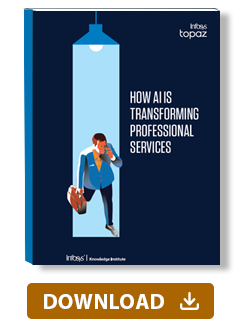Insights
- Professional services providers are inherently suited for AI due to their reliance on expertise, collaboration, and knowledge work.
- Large Language Models help providers extract value from unstructured data like emails and reports without needing major IT changes.
- The sector shows strong AI performance, with low failure rates and a steady flow of successful use cases.
- Providers that implement AI with clear strategy, governance, and employee support achieve better outcomes.
- With minimal infrastructure changes, AI enables PS providers to improve efficiency and strengthen market position.
Executive summary
Artificial intelligence (AI) is no longer a future concept — it is actively transforming industries, with professional services emerging as a front-runner. Built on expertise, collaboration, and trust, this sector is leveraging AI not just to improve efficiency, but to rethink how work is done, how knowledge is accessed, and how value is delivered to clients.
A global survey by Infosys captured insights from 3,798 senior executives across over 3,200 companies — including 250 executives from 215 professional services organizations. The data reveals that professional services rank among the top industries in AI success, with a viability score of 1.18 (Figure 1), indicating that AI projects are more likely to meet business goals. Nearly 50% of initiatives are already deployed and delivering value, while just 15% are underperforming — well below the 26% cross-industry average. A strong pipeline of planned projects points to continued momentum.
Professional services companies are applying AI in ways that align with the core of their business. Cybersecurity and compliance are top areas of focus — where AI automates data extraction, flags regulatory changes, and improves fraud detection. Other high-value applications include software development, where generative AI is used to draft contracts, summarize documents, and improve semantic search. They are also deploying AI to match talent more efficiently to projects, personalize customer service, and accelerate the review and generation of complex content — all of which help professionals focus on high-impact, judgment-driven work.
What sets this sector apart is its ability to unlock value from the unstructured data that fuels professional decision-making — meeting notes, emails, contracts, client memos, and more. Traditionally, this data has been difficult to digitize or leverage. Now, large language models (LLMs) and agentic AI can analyze and act on this information without the need for IT overhauls. This gives them a powerful advantage: they can drive AI outcomes with lower transformation costs and fewer system dependencies than many other industries.
Still, not all businesses are moving at the same pace. While some are scaling AI successfully, others remain stuck in pilot mode, experimenting with tools in isolation rather than driving transformation at scale. To realize AI’s full potential, professional services firms need a more structured, enterprise-wide approach — one that aligns AI adoption with strategic goals, governance models, and workforce engagement.
The opportunity is clear. AI enables professional services organizations to work smarter, respond faster, and deliver more tailored value to clients without compromising the human judgment and relationships that define the industry. The firms that embed AI into their core operations today will not only gain an edge — they will set the standard for how services are delivered tomorrow.
Figure 1. Professional services lead in generating high value
A viability score above 1 indicates a use case type is more likely to deliver business objectives, with a score of less than 1 being less likely. The viability score is the weighed average of deployments achieving some or all business objectives compared to the total deployments of the use case type.
Source: Infosys Knowledge Institute
The rise of AI in professional services
Professional services providers, whether law firms, accounting practices, consultancies, or design agencies, have always relied heavily on human expertise and judgment.
Traditionally, these businesses operated through in-person consultations, lots of paperwork, and highly personalized service. But as clients’ needs become more complex, unstructured data piles up, and pressure to boost productivity grows, AI is becoming an increasingly appealing tool to deliver those productivity increases.
According to a global survey conducted by Infosys, which captured insights from over 3,700 business leaders, professional services emerged as one of the top-performing industries in terms of AI success. With a viability score of 1.18, the sector ranks at the top alongside innovation leaders like life sciences and high tech.
The viability score is a weighted measure that reflects how often AI deployments achieve full or partial success in meeting business goals. A score above 1 indicates above-average potential for value realization, while a score below 1 highlights underperformance or misalignment. This makes viability a more meaningful indicator than investment alone.
Notably, around 50% of use cases in this industry have AI initiatives that are fully deployed and already delivering on most or some of their business objectives, pretty much in line with the overall average of 51% (Figure 2).
What really sets professional services apart, though, is its low rate of projects that either got canceled or are not delivering business value — just 15%, compared to 26% across all industries.
This means a bigger share of professional services use cases have initiatives that are actually deployed and creating impact.
Furthermore, the most advanced initiatives in 18% of use cases are still in the planning stage, which indicates there’s a strong pipeline ahead, which in turn is signaling that the transformation journey is far from over.
Figure 2. Stage of use case deployments
Source: Infosys Knowledge Institute
Key AI applications in professional services
As part of Infosys’ research, we explored how AI is being used across different functional areas — broad business functions that cut across industries. Figure 3 shows the selection rate, which reflects how often respondents ranked a functional category among the top five AI use case areas in professional services compared to the overall average. Interestingly, some AI use cases are even more common in professional services than in the broader survey group (Figure 3, use cases in boxes). These areas generally align with the core activities of the sector, including:
Cybersecurity and resilience
AI is making compliance easier by automating data extraction and monitoring regulatory changes. In tax and audit, it speeds up work by pulling data from invoices and receipts, reducing errors along the way. Regulatory bots keep track of rule changes across jurisdictions and update compliance checklists in real time. ML also improves audit accuracy by spotting anomalies in large datasets, helping businesses detect fraud risks more effectively than traditional sampling.
Software development
AI is transforming software development in professional services by enabling smarter automation, deeper insights, and faster delivery. Tools like natural language processing (NLP) and generative AI are streamlining document review, contract drafting, and content creation, cutting down manual effort and improving accuracy. Machine learning powers predictive modeling, anomaly detection, and sentiment analysis, helping enterprises anticipate risks and make better decisions. Developers are also building semantic search engines which understand the meaning behind queries rather than just matching keywords and chatbots to improve knowledge access and client support. By embedding AI into workflows, organizations are speeding up operations and freeing professionals to focus on creativity, judgment, and client relationships.
Workforce
AI is changing how businesses manage talent by improving allocation and compensation decisions. AI-powered talent matching tools review resumes and project histories to assign the best consultants to each engagement, improving win rates and resource utilization while intelligent systems match consultants to the right projects based on their skills and experience, boosting utilization and win rates. Machine learning models also benchmark pay against market trends, helping them make fair, data-driven compensation decisions without the manual work.
Customer service
AI is elevating client service by automating routine interactions and providing deeper insights into client sentiment. For example, 24/7 chat assistants handle routine client queries, schedule meetings, and collect intake information, ensuring a responsive and seamless experience. At the same time, sentiment analytics monitor call transcripts and emails to detect shifts in client sentiment, enabling businesses to address concerns early and tailor their engagement strategies to strengthen client relationships.
Content intelligence
AI-powered tools are simplifying the creation, analysis, and management of complex documents. In legal and consulting work, NLP systems review large volumes of text and flag relevant clauses or evidence faster and more accurately than manual methods. Generative AI helps draft contracts, reports, and presentations, while automation tools handle tasks like meeting minutes and emails — letting professionals focus on strategy rather than admin.
Figure 3. Functional use cases comparison
Source: Infosys Knowledge Institute
Unlock the value of unstructured knowledge
One of the biggest challenges in professional services has always been managing unstructured and tacit knowledge. Think about all the different formats this takes — emails, meeting notes, slide decks, contracts, client memos, and even those valuable insights that live in people’s heads. Most of this information isn’t sitting neatly in a central database; it’s scattered across inboxes and conversations. Traditionally, this kind of data has been tough to automate or analyze with standard computing methods.
That’s where modern AI comes in. Large language models (LLMs) and generative AI have changed the game. These tools can understand, process, and even generate natural language with impressive fluency. And now, agentic AI takes it a step further by orchestrating workflows on the fly — choosing the right tools and application program interfaces (APIs) that allow different software systems to communicate and interact in real time based on context and input quality. For professional services providers, this means they don’t need to spend millions on massive digitization projects. Instead, they can use LLMs to work directly with the data they already have.
Imagine a consulting business using generative AI to summarize thousands of client emails and meeting notes, spotting emerging issues or shifts in client sentiment. Consultants can then proactively tailor their advice. Or picture a law firm using LLMs to draft or review contract clauses by scanning existing agreements — speeding up turnaround times and reducing errors. However, many of these use cases especially in sensitive domains like legal services require close human oversight to ensure accuracy, compliance, and ethical standards are upheld.
This leap in capability lowers the barriers to adopting AI and opens up opportunities to improve knowledge sharing, decision-making, and client engagement.
Why the sector is primed for AI success
Building on this momentum, it’s clear why professional services are emerging as one of the most promising sectors for AI adoption. Several factors make this industry uniquely positioned to succeed:
1. Human-centric operating models
Professional services revolve around people, including clients, consultants, lawyers, accountants, and advisors who work collaboratively to solve complex problems. Unlike industries that aim to automate away human labor, AI in this sector is used to augment human expertise, not replace it.
Tools powered by LLMs and generative AI help professionals become more efficient and insightful by summarizing meeting notes, drafting client communications, generate first-pass versions of legal or financial research, and more, while leaving final judgment and decision-making to human experts.
2. Low transformation requirements
One of the key reasons professional services providers are seeing strong success with AI adoption is that most use cases do not require major overhauls to their existing IT systems or data infrastructure. Unlike industries where legacy systems can pose significant barriers, the operating models and data architectures in professional services are already well-aligned with the requirements of modern AI technologies — particularly those involving natural language processing and document-based workflows.
Analysis of the survey data indicates most of the AI use cases are represented by green dots clustered in the lower part of the average spend-viability quadrant (Figure 4). This positioning indicates that these AI applications can be implemented with relatively low transformation effort and lower average spending yet still deliver business value more often. Only a small subset of use cases represented in red falling into the higher transformation category require complex integration or structural changes.
Interestingly, the Infosys AI Business Value Radar highlights that unlocking value from AI typically requires upfront transformation. However, professional services emerge as a notable outlier. This sector already ranks high in AI viability without needing extensive transformation, thanks to its ability to leverage existing unstructured data and workflows. This alignment enables businesses to deploy AI more quickly, more cost-effectively, and with fewer disruptions to existing operations.
3. Strategic clarity
Professional services businesses also benefit from a clear understanding of which workflows need AI-driven transformation. They tend to be highly intentional about selecting use cases — focusing on those that align closely with business goals such as improving customer experience, increasing operational efficiency, or enhancing compliance. This strategic clarity helps ensure that AI investments are directed toward areas with the highest potential impact. A great example of this is Infosys Wingspan, a digital learning and collaboration platform that uses AI to personalize learning journeys, recommend relevant content, and facilitate knowledge sharing across teams. By embedding AI into a core workflow, Infosys has been able to drive measurable improvements in employee engagement and productivity without requiring large-scale structural changes. This kind of targeted transformation illustrates how professional services organizations can unlock value from AI quickly and effectively.
Figure 4. Highly viable use cases require less transformation and spending
Source: Infosys Knowledge Institute
4. Commitment to change management
As part of our research, Infosys identified four archetypes of progress towards becoming AI-first businesses (Figure 5). We found that 26% of professional services organizations are considered AI trailblazers as compared to overall average of 16% which means professional services leaders that not only deploy AI technologies but also invest meaningfully in the cultural and organizational shifts required for success.
These businesses understand that technology alone is not enough. They prioritize employee engagement, training, governance, and transparent communication, which significantly improves adoption and return on investment. In this environment, AI becomes a collaborative enabler, rather than a top-down mandate or an isolated experiment.
Figure 5. Workforce readiness and AI
Source: Infosys Knowledge Institute
From experimentation to execution
Despite the promise of AI, not all businesses are moving at the same pace. Some are still in the exploration phase, piloting tools without a clear strategic framework. This “dabbling” approach can result in wasted resources and missed opportunities.
To fully realize AI’s potential, professional services providers must move from experimentation to execution. A deliberate, structured strategy is key. AI should be integrated into the organization’s overall goals, with clear governance, change management, and metrics for success.
Here are three crucial steps to guide this transformation:
- Accelerate AI adoption: Given the natural alignment between AI capabilities and the needs of professional services, businesses should scale up successful pilots and invest in enterprise-wide AI initiatives. The most impactful opportunities lie in functions that are both high-volume and knowledge-intensive.
- Prioritize structured implementation: AI success depends not just on technology but on people and process. Providers that engage employees, build AI literacy, and implement robust governance structures are seeing the greatest returns. Leadership buy-in and cross-functional collaboration are essential.
- Leverage AI for competitive advantage: With the sector’s relatively low transformation burden, there is a clear opportunity for businesses to leap ahead of competitors. AI can drive operational efficiency, enhance client value, and position companies as innovation leaders in a traditionally conservative industry.
The road ahead
By enhancing decision-making, reducing administrative burden, and surfacing insights from complex data, AI is enabling professional services businesses to deliver greater value to clients while also improving internal performance. AI augments human capabilities by helping professionals work smarter, faster, and with more precision.
Yet this transformation is still in its early stages. The businesses that succeed will be those that approach AI not as a one-off project but as a strategic capability which is deeply embedded in how they serve clients, manage talent, and innovate.
For those that wait, the risk is not just falling behind technologically but becoming irrelevant in a world where clients expect smarter, faster, and more personalized service.
Appendix A: Use cases
Based on interviews with subject matter experts and desk research, we collated 55 use case types across 14 categories (Figure A1). We similarly collated 77 industry-specific use case types across 15 industry sectors (Figure A2). All these use case types are themselves at a level of abstraction higher than a specific use case, to make the survey manageable — but they are also relevant for all respondents. The survey asked respondents to select up to five functional categories out of 14 (Figure A1) where their companies are pursuing AI. Respondents provided details on these categories, which were the top five that their company is already interested in. As such, this is a self-selecting sample. In Figure 1, for example, we would typically expect far more projects that had failed, been canceled, or been in pilots for what is an early stage and experimental technology. Each category had between two and six common use case types (for example, product recommendation use cases in the sales and retail category). For each use case type within a category, respondents were asked about the stage of implementation of their initiative(s). Options for this question were: No plans to implement; planning; created proof of concept or pilot; canceled before deployment; deployed, not generating business value; canceled after deployment; deployed, generating some business value; deployed, achieving most or all objectives. Respondents were then asked about the amount of spending for that use case type to date (from any start date). This was followed by questions about the amount of operational or business model change as well as the amount of change in data structures and technical architecture needed for each use case type.
Finally, respondents were asked about the proportion of their user base that accepted and used the AI tool deployed (if any) for each use case type. The same series of questions was asked for industry-specific use case types for the industry of the respondent (Figure A2).
Figure A1. Functional categories and their use case types
Source: Infosys Knowledge Institute
Figure A2. Industry-specific use case types
Source: Infosys Knowledge Institute
Appendix B: Research approach
Source: Infosys Knowledge Institute














